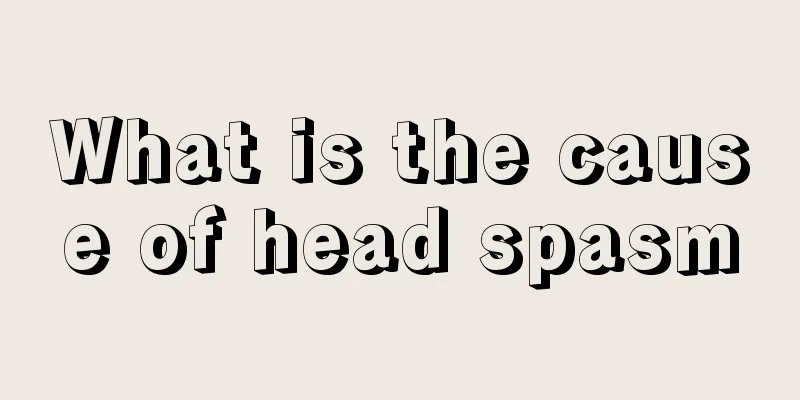What is the cause of head spasm

|
Body cramps are quite common and are often related to sudden cold or improper exercise. But what causes head spasms? Head spasm is actually a phenomenon related to blood vessels, which also includes the cause of blood clots compressing blood vessels and causing structural damage. In addition, sudden outbursts of emotions can also cause head spasms, so the elderly are more likely to suffer cerebral hemorrhage when they are angry. 1. What causes cerebral vasospasm? 1.1 Mechanical stimulation factors (30%) Compression from encapsulated blood clots and vascular nutritional disorders lead to damage to the vascular wall structure; damage caused by the oxidation of oxygenated hemoglobin into methemoglobin and the release of oxygen free radicals; various other vasoactive substances, such as 5-HT, have a vasoconstrictive effect; increased intracranial pressure, excessive dehydration treatment without timely replenishment of blood volume; and factors such as vascular wall inflammation and immune response. 1.2. Functional factors (30%) Simple cerebral vasospasm is a cerebrovascular dysfunction caused by various factors. There is no substantial damage or lesions in the cerebral blood vessels. Most patients are young people with better self-regulation ability, so the prognosis is good. Most patients can recover completely after treatment and relaxation. 1.3 Other factors (40%) Emotional fluctuations, anger, psychological disorders, and stress are the most common causes of cerebral vasospasm. Most patients are students. Insomnia can also cause cerebral vasospasm. 2. What are the common symptoms of cerebral vasospasm? 2.1. During the period of cerebral vasospasm, clinical symptoms often include increased intracranial pressure (headache, vomiting, swelling of the corners of the eyes) and confusion. 2.2 The patient changes from being awake to being drowsy or comatose; or from being comatose (early cerebral vasospasm recovers in a short period of time) to being awake and then to being comatose again (cerebral vasospasm occurs again, i.e., relapses). This alternating change of consciousness within the brain is a prominent feature of cerebral vasospasm. 2.3. Focal signs of cerebral vasospasm may appear or worsen to varying degrees, such as hemiplegia, hemisensory disturbance, aphasia, etc. 2.4. The patient has a persistent fever, which is manifested by a continuous increase in the number of peripheral white blood cells. 2.5. Persistent headache, dull pain in the head, feeling of oppression and heaviness. Some patients complain of a feeling of "tightening" of the head. When dizziness occurs, the patient dares not move and must stay in bed, especially unable to move the head. In severe cases, the patient may experience nausea and severe vomiting. Chest tightness, palpitations, shortness of breath, sense of urgency in breathing, unclear mind, affected thinking and memory. 3. What tests should be done for cerebral vasospasm? 3.1. Digital subtraction angiography (DSA). It is the "gold standard" for the diagnosis of cerebral vasospasm, has a high positive detection rate for aneurysms and cerebral vascular malformations, and can clearly display the branches of cerebral blood vessels at all levels. 3.2. Transcranial Doppler ultrasound (TCD). It is currently a commonly used method for detecting cerebral vasospasm. If the blood flow velocity in local cerebral blood vessels is found to be increased, it indicates the presence of vascular stenosis caused by vasospasm. 3.3, CT. The diagnostic accuracy rate is high for acute subarachnoid hemorrhage occurring within 12 hours, and the location of intracranial aneurysm can be indirectly inferred based on this. 3.4. CT angiography (CTA) and magnetic resonance angiography (MRA). High-resolution CTA and CT perfusion imaging can accurately diagnose severe vasospasm of major intracranial blood vessels, but they still have certain limitations in diagnosing vasospasm of small arteries and distinguishing between mild and moderate spasm. |
<<: What are your skin problems?
>>: How to make roast duck delicious
Recommend
Do not apply ginger randomly to treat alopecia areata
The treatment of alopecia areata should first act...
Brown spots suddenly appear on the body
Brown spots suddenly appear on your body, which i...
Bleeding pornographic video
The names of many movies will evoke associations ...
Does mango have a high sugar content?
What is certain is that mangoes have a relatively...
Get white arms quickly in one week
In summer, many girls like to show their arms. Wh...
What are the dietary treatments for residual gastric cancer
Experts say that gastric remnant cancer is also c...
What is the most effective way to treat lung cancer? These lung cancer treatments are the best available
So far, the most effective method for treating lu...
The efficacy and function of camphor oil
In nature, many trees also have magical effects a...
What causes chest tightness and difficulty breathing?
I often feel chest tightness and difficulty breat...
What is the preferred test for diagnosing colon cancer at present?
The fast-paced society has caused subtle changes ...
What are the taboos for women to eat bird's nest
Bird's nest contains high-quality protein and...
Topical medication for skin cancer
Skin cancer patients can try some topical medicat...
What Chinese medicine can I take for cervical cancer without surgery
Cervical cancer is a disease that female friends ...
What are the methods for correcting scoliosis?
Scoliosis is a relatively common symptom of spina...
Is it good to drink bottled mineral water for a long time?
Many people always think that tap water is unhygi...









